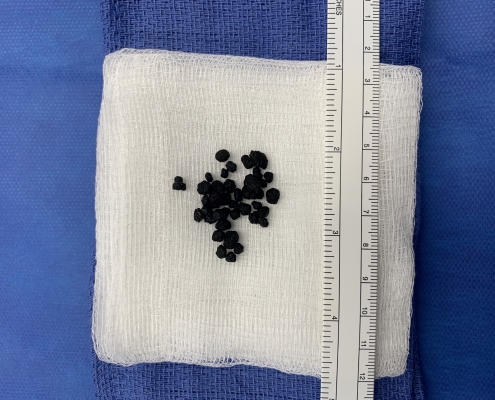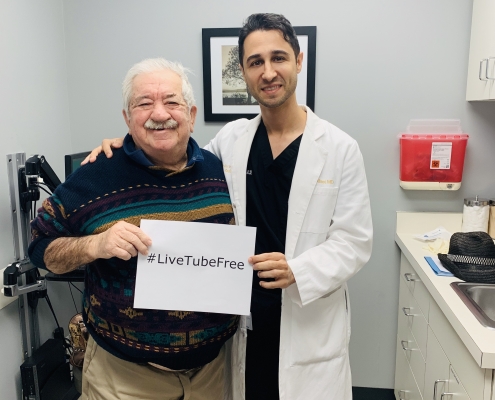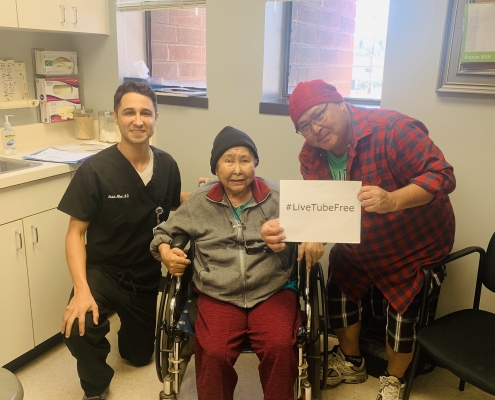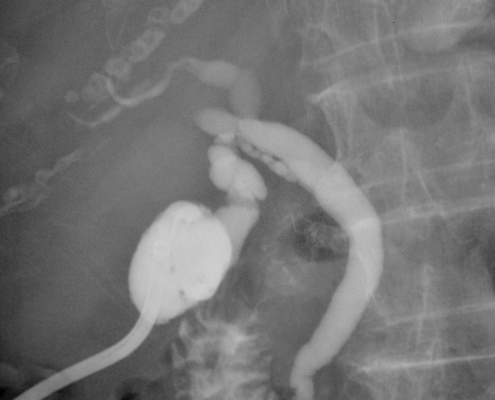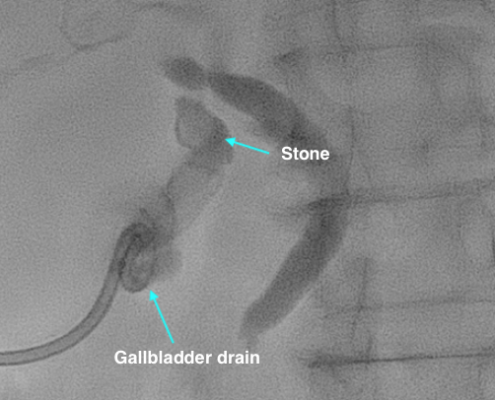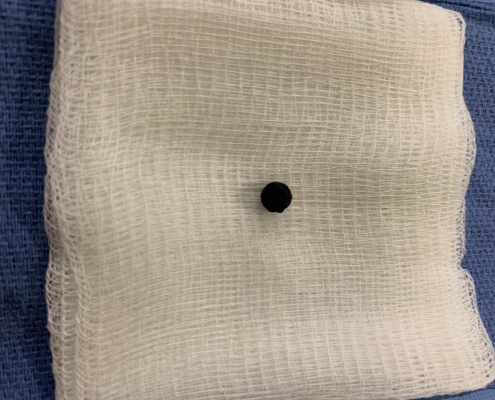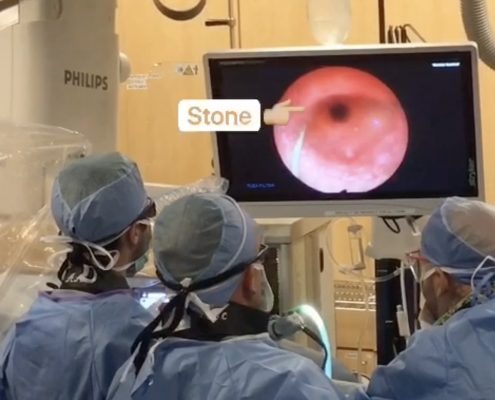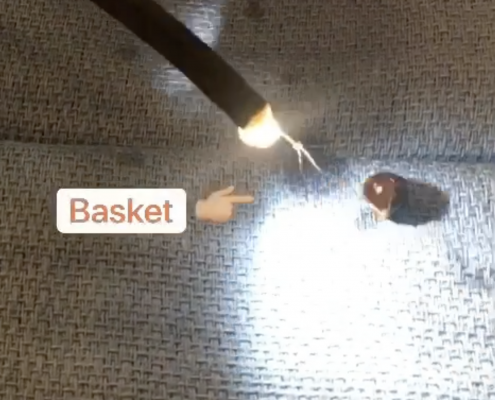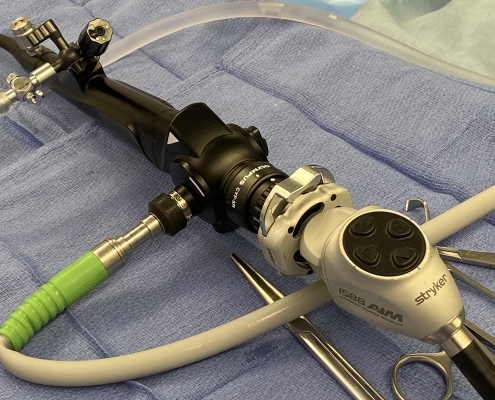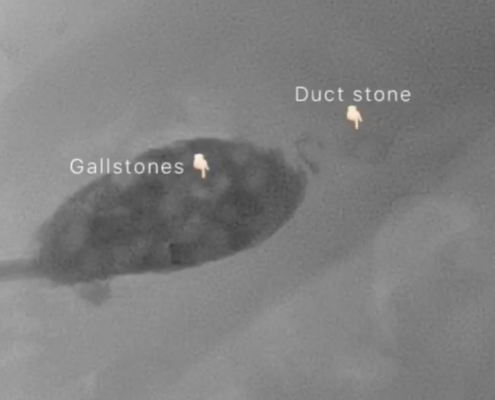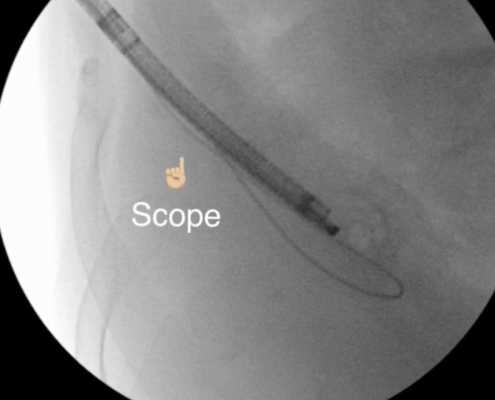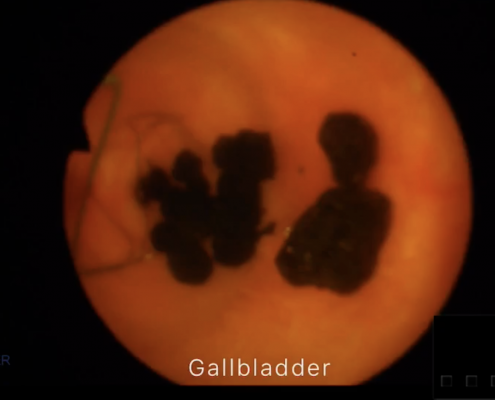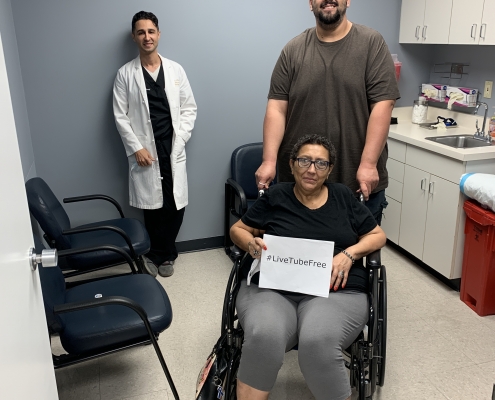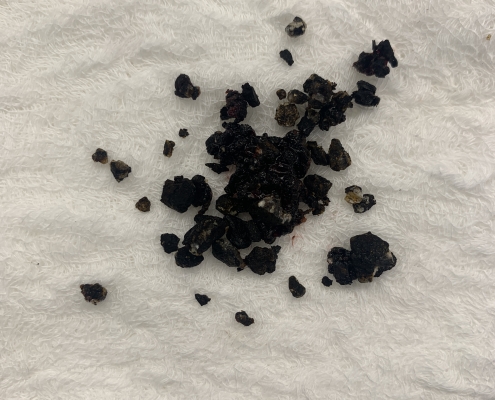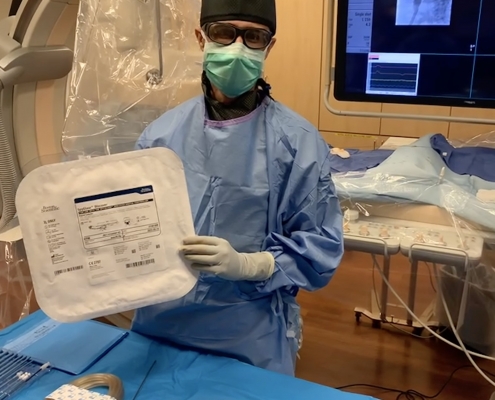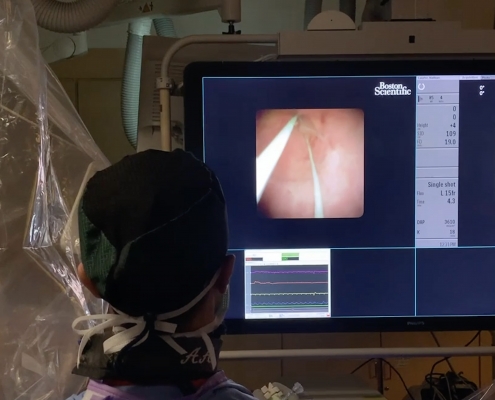Gallstones
Gallstones can cause pain that is usually on the right side or middle of your upper belly, may be constant or worse after a heavy meal, may sometimes feel more like fullness than pain, may be felt in your back and in the tip of your right shoulder blade. Other symptoms may include nausea, vomiting, fever, and chills. The symptoms of gallbladder problems may look like other health problems. Always see your healthcare provider to be sure.
Non-Surgical Gallstone Removal
Percutaneous endoscopic procedure is a technique that can be used to treat patient that have gallstones, known as cholelithiasis, but cannot undergo surgery for gallbladder removal due to other medical issues. Often times these patients end up with a gallbladder drain, a cholecystostomy tube, that cannot be removed because of the risk of recurrent pain and symptoms.
There may also be stones in the bile ducts, known as choledocholithiasis.
This procedure is performed by our trained interventional radiologists, a doctor who uses X-rays and other advanced imaging to see inside the body and treat conditions without surgery. Our interventional radiologist using direct visualization with a camera and X-ray guidance from a fluoroscopy machine that allows for control of the instruments used to remove the stones.
Non-Surgical Gallstone Removal and Choledoscopy Candidate
Endoscopic gallstone removal is typically for patients who are too old or high risk to have traditional gallbladder surgery or who have bile duct stones that cannot be removed in the standard fashion. Sometimes this treatment can be offered to patient who have strong medical, religious or personal reasons for not wanting their gallbladder removed.
If you have had a gallbladder drain placed for gallstones but cannot get your gallbladder surgically removed, then you are potentially a candidate for this procedure.
Our specialist has treated a number of patients who are over 80 years old and too sick to undergo surgery. The lower risk profile makes this an ideal procedure for older patients or those with a number of medical issues to undergo surgery. Since this procedure can be performed with twilight sedation, this also eliminates the risks of general anesthesia and intubation. This is a safe and effective procedure when performed by our experienced interventional radiologist with an understanding of the techniques needed to reduce complications.
Non-Surgical Gallstone Removal Procedure
Percutaneous endoscopy is performed through the existing gallbladder drain tract. If you don’t have a gallbladder drain, this will need to be placed.
After 4-6 weeks a tract will form around the gallbladder drain, this is required to prevent any leakage of stones or bile into the abdomen. Once it is confirmed that there is a formed tract, the endoscopic procedure can then be schedule.
Sometimes the size of the drainage catheter is increased prior to removal of the stones so that the tract is larger to accommodate the camera. This depends on the size of the stones.
On the day of the procedure, the drain is exchanged for a larger temporary access into the gallbladder that will fit the endoscopic camera. Iodinated contrast material maybe injected into the bile ducts to locate gallstones that maybe causing blockage. Small stones are removed using a basket that fits through the camera. Other stones can be washed out by irrigating the gallbladder with saline or water.
Larger stones can be fragmented under endoscopic guidance with a precisely directed holmium laser. The gallbladder is filled with sterile water prior to fragmentation as the laser beam is absorbed by water, preventing damage to the gallbladder wall.
On average, it takes two sessions to clear patients of their stones if there is a large stone burden. After the stones are removed, the tube will stay in place for a couple of weeks to ensure the gallbladder/bile system is still intact and functioning normally. Once this is confirmed, the tube is then removed. The tract heals and closes on its own and does not require any suture or surgery.
How to Prepare for Non-Surgical Gallstone Removal Procedure
Prior to the Procedure
You may not eat or drink eight hours prior to the procedure.
If you are on blood-thinning medication, ask your provider if you need to stop it prior to the procedure.
During the Procedure
You will be asked to change into a gown before the procedure.
Labs maybe obtained.
You will be given a sedative by the anesthesia nurse, who will be present to monitor your vital signs during the examination. Typically the procedure is done with a “twilight sedation.”
After the Procedure
This is an outpatient procedure and does not require hospital stay.
You will remain in a recovery room until most of the effect of the sedative has worn off.
Because of sedation used during the procedure, you’ll need to make plans to have someone take you home.
What are the Risks?
Discomfort at the insertion site
Infection
Nausea
Bleeding
Bile duct or gallbladder injuries like perforation
Results:
We have successfully treated many patients with complete removal of the gallstones. This has rendered them tube free, which is a huge relief for patients and their family.
Gallstones
Gallstones can cause pain that is usually on the right side or middle of your upper belly, may be constant or worse after a heavy meal, may sometimes feel more like fullness than pain, may be felt in your back and in the tip of your right shoulder blade. Other symptoms may include nausea, vomiting, fever, and chills. The symptoms of gallbladder problems may look like other health problems. Always see your healthcare provider to be sure. 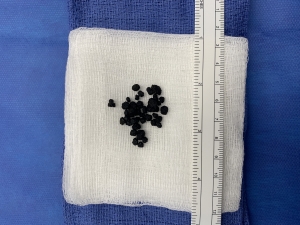
Non-Surgical Gallstone Removal
Percutaneous endoscopic procedure is a technique that can be used to treat patient that have gallstones, known as cholelithiasis, but cannot undergo surgery for gallbladder removal due to other medical issues. Often times these patients end up with a gallbladder drain, a cholecystostomy tube, that cannot be removed because of the risk of recurrent pain and symptoms.
There may also be stones in the bile ducts, known as choledocholithiasis.
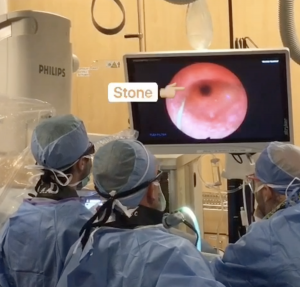
This procedure is performed by our trained interventional radiologists, a doctor who uses X-rays and other advanced imaging to see inside the body and treat conditions without surgery. Our interventional radiologist using direct visualization with a camera and X-ray guidance from a fluoroscopy machine that allows for control of the instruments used to remove the stones.
Non-Surgical Gallstone Removal and Choledoscopy Candidate
Endoscopic gallstone removal is typically for patients who are too old or high risk to have traditional gallbladder surgery or who have bile duct stones that cannot be removed in the standard fashion. Sometimes this treatment can be offered to patient who have strong medical, religious or personal reasons for not wanting their gallbladder removed.
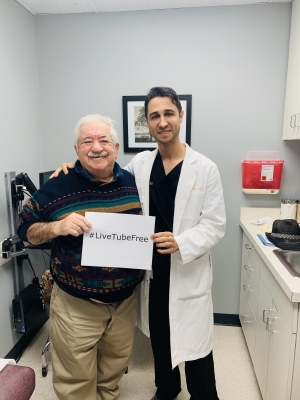
If you have had a gallbladder drain placed for gallstones but cannot get your gallbladder surgically removed, then you are potentially a candidate for this procedure.
Our specialist has treated a number of patients who are over 80 years old and too sick to undergo surgery. The lower risk profile makes this an ideal procedure for older patients or those with a number of medical issues to undergo surgery. Since this procedure can be performed with twilight sedation, this also eliminates the risks of general anesthesia and intubation. This is a safe and effective procedure when performed by our experienced interventional radiologist with an understanding of the techniques needed to reduce complications.
Success Rate of Non-Surgical Gallstone Removal Cholangioscopy
Endoscopic and fluoroscopic-guided gallstone removal is highly successful, with complete stone removal from the gallbladder or bile ducts occurring in 80% of cases. This has a significant impact on patients and their family who are left to care for the drainage catheter, which would be otherwise for the rest of the patient’s life. After the procedure, the catheter can be removed allowing the patient to have a better quality of life.
Non-Surgical Gallstone Removal Procedure
Percutaneous endoscopy is performed through the existing gallbladder drain tract. If you don’t have a gallbladder drain, this will need to be placed.
After 4-6 weeks a tract will form around the gallbladder drain, this is required to prevent any leakage of stones or bile into the abdomen. Once it is confirmed that there is a formed tract, the endoscopic procedure can then be schedule.
Sometimes the size of the drainage catheter is increased prior to removal of the stones so that the tract is larger to accommodate the camera. This depends on the size of the stones.
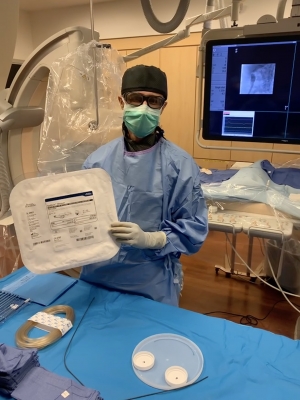
On the day of the procedure, the drain is exchanged for a larger temporary access into the gallbladder that will fit the endoscopic camera. Iodinated contrast material maybe injected into the bile d
ucts to locate gallstones that maybe causing blockage. Small stones are
removed using a basket that fits through the camera. Other stones can be washed out by irrigating the gallbladder with saline or water.
Larger stones can be fragmented under endoscopic guidance with a precisely directed holmium laser. The gallbladder is filled with sterile water prior to fragmentation as the laser beam is absorbed by water, preventing damage to the gallbladder wall.
On average, it takes two sessions to clear patients of their stones if there is a large stone burden. After the stones are removed, the tube will stay in place for a couple of weeks to ensure the gallbladder/bile system is still intact and functioning normally. Once this is confirmed, the tube is then removed. The tract heals and closes on its own and does not require any suture or surgery.
How to Prepare for Non-Surgical Gallstone Removal Procedure
Prior to the Procedure
You may not eat or drink eight hours prior to the procedure.
If you are on blood-thinning medication, ask your provider if you need to stop it prior to the procedure.
During the Procedure
You will be asked to change into a gown before the procedure.
Labs maybe obtained.
You will be given a sedative by the anesthesia nurse, who will be present to monitor your vital signs during the examination. Typically the procedure is done with a “twilight sedation.”
After the Procedure
This is an outpatient procedure and does not require hospital stay.
You will remain in a recovery room until most of the effect of the sedative has worn off.
Because of sedation used during the procedure, you’ll need to make plans to have someone take you home.
What are the Risks?
Discomfort at the insertion site
Infection
Nausea
Bleeding
Bile duct or gallbladder injuries like perforation
Results:
We have successfully treated many patients with complete removal of the gallstones. This has rendered them tube free, which is a huge relief for patients and their family.

